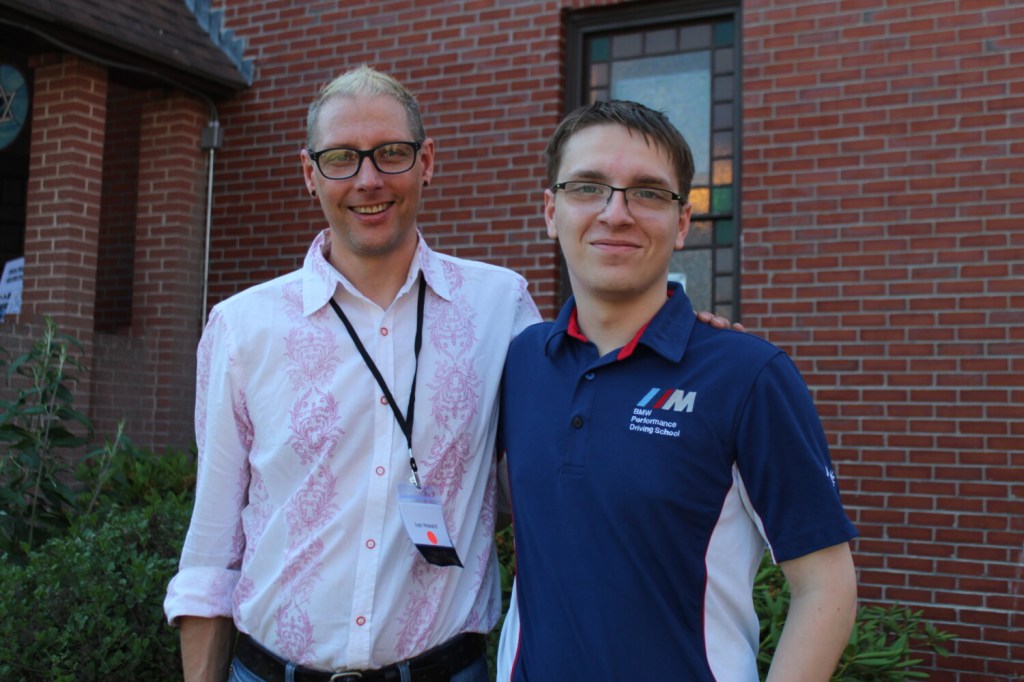Congregation Etz Chaim, the last remaining synagogue in what was once a Jewish neighborhood at the base of Portland’s Munjoy Hill, celebrated a century of birth, growth and rebirth with an anniversary garden party and commemorative program June 26.
“At the time this was built, there were three synagogues in three blocks,” said Rabbi Gary Berenson, gesturing toward Congress Street. “This was the Jewish section of town, and today this is all that remains in this neighborhood.”
The key to Etz Chaim’s longevity, Berenson said, has been willingness to change over time. What was established in 1921 as a traditional Orthodox synagogue in a walkable neighborhood has become the home of Maine Jewish Museum and a non-affiliated Jewish faith community for 300 southern Maine families.
The road to all that change hasn’t been without some bumps. After World War II, many young Jews chose to raise families in the more suburban Woodfords neighborhood rather than downtown. As a result, Etz Chaim membership fell into decades of decline, and heating a large sanctuary with a dome ceiling and large stained-glass windows became unmanageable. Services moved to the smaller downstairs chapel, while the stained glass was bricked over and the sanctuary ceiling lowered.
By the 1990s, the congregation had shrunk to about 15 families.
Then, in 2003, Rabbi Harry Sky rekindled interest in Etz Chaim with a simple but revolutionary campaign: “Jews without boundaries.” Etz Chaim would be egalitarian and open to anyone – regardless of religious upbringing or sexual orientation.
The congregation also established Maine Jewish Museum, which hosts art exhibits and events and runs and maintains the building, leasing the facilities back to the synagogue.
While other synagogues in the neighborhood have become offices or empty lots, all these changes kept Etz Chaim alive.
When Rabbi Sky retired, longtime lay leader Berenson, who ran B&B Cleaners on Washington Avenue, went to seminary. And Rabbi Berenson has been leading the congregation since 2014.
“He has been leader, organizer, rabbi, and the list goes on and on,” said board president Mark Aranson.
Under Berenson’s leadership, the congregation not only grew, it mobilized.
“People came together to fundraise to renovate the building,” said volunteer Alison Brown. “There’s a lot of feeling in the Jewish community about this place because their parents or grandparents were here at the beginning.”
The false ceiling was removed from the second-floor sanctuary, exposing parts of the synagogue that hadn’t been seen in four decades. The bricks came off the stained windows, and the same company that had originally made the windows made them whole again.
That might have been the happy ending to this story of rebirth of a place of worship and cultural heritage. But then, in May 2020, fire broke out behind the ark in the main sanctuary. Much of what fire didn’t destroy, fire hoses did. It could have been a total loss.
But, thanks to insurance and community fundraising, the congregation rebuilt. Again. Walls, ceilings and floors were restored. Light fixtures were replaced or rewired. Stained glass was repaired. New curtains for the ark were donated. Even the Torahs were sent out for repair, and all but one of them saved.
During this second renovation, the sanctuary ceiling – which had been painted white – was restored to what it looked like a century ago: blue sky with clouds.
The building’s restoration was complete in time for Etz Chaim’s centennial celebration, attended by members, supporters and representatives of the larger Jewish community.
“Very few congregations can reinvent themselves in this way,” said guest speaker Michael Cohen, a professor of Jewish studies at Tulane University. “It’s not an easy feat for a synagogue to survive a century.”
Even members of the congregation who have witnessed the decades of birth, growth and rebirth of Etz Chaim wondered at the unlikeliness of its survival into a second century.
“It surprises me that we are still together and still want the same things we wanted when this started,” said Helen Isenman, who has worshipped at Etz Chaim since the 1950s. “But we’re a family.”
Amy Paradysz is a freelance writer and photographer from Scarborough. She can be reached at amyparadysz@gmail.com.
Send questions/comments to the editors.










Comments are no longer available on this story